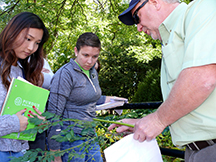Purdue Arboretum offers online database of plants on campus
October 2, 2014
 |
|
Dawn Tse (left) of Hong Kong and Mirandi Miller of Shipshewana, Indiana, both landscape architecture sophomores at Purdue University, are focused on learning about a Kentucky coffeetree as explained by limited-term lecturer David Listerman of Listerman and Associates Inc. of Xenia, Ohio, during the woody ornamental identification class’ campus walk through on a late-September afternoon. The class stopped at many plants throughout the campus-wide Purdue Arboretum. (Purdue Agricultural Communication photo/Keith Robinson) |
WEST LAFAYETTE, Ind. - Purdue University is rolling out a comprehensive online interactive database of the campuswide Purdue Arboretum for students and visitors to enhance their learning and appreciation for plants and the environment.
The Purdue Arboretum Explorer allows mobile device users to quickly locate and learn about the nearly 779 types of trees, shrubs and vines that comprise over 40,000 plants that are mapped throughout campus. It also allows users to learn about the university's environmental stewardship initiatives as well as historical landmarks, campus art, and other landscape features at Purdue.
The goal of the arboretum is to enhance the university’s educational, research and outreach mission, promote environmental sustainability and add to the beauty of the 956-acre campus.
"It is an opportunity to reach out not only to our students and researchers but to the public so they can interact with nature and better appreciate plants," said Paul Siciliano Jr., a professor of horticulture and landscape architecture and the arboretum's director.
The arboretum is a "living laboratory" and "classroom" for many courses taught in the life science fields such as horticulture, landscape architecture, botany, forestry, plant pathology and entomology as well as in the earth sciences and liberal arts.
In addition, elementary and secondary school students as well as community groups and other visitors benefit from the arboretum as they often use the campus to study plants and learn about sustainable landscape practices by exploring the many "green" initiatives implemented throughout the grounds.
Michael Gulich, director of university sustainability, called the Purdue Arboretum Explorer "an unparalleled educational resource for our campus community."
"It is a great example of the living laboratory initiative, where students and faculty can be involved with the ongoing sustainable maintenance of a world-class arboretum," Gulich said.
The arboretum features signage of the 779 unique taxa - species, subspecies, variety, formas and cultivars - on campus so they can be readily identified. The signs are labeled with QR codes that anyone can scan with a mobile phone and link to that plant's information in the Purdue Arboretum Explorer database on the arboretum's website http://www.arboretum.purdue.edu/. Plants can be searched by their common or scientific name or by special characteristics such as flower color, leaf color and plant function. Users also can enter a set of dates to learn which plants are likely to be flowering or fruiting during that time.
At least 25 students have been involved with the arboretum since its inception in 2008, mapping the location of plants throughout the university, installing plant signage, taking pictures of the plants and entering plants' characteristics in the database, among other arboretum tasks.
"The best part about this project is the involvement of students," Siciliano said. "It's through the hard work and dedication of the students that this has been a success."
Siciliano has received inquiries from faculty members at other universities throughout the country inquiring about how to start a similar online plant database of their campus landscape.
The arboretum has regularly updated and extended its woody plant inventory and obtained international accreditation through Arbnet, administered through the Morton Arboretum. The university has earned the Tree Campus USA title, administered through the Arbor Day Foundation, every year since 2009.
In the fall of 2013, the arboretum was integrated into the woody landscape plants (HORT 217) class and began implementing a small native woody plants nursery at Purdue's Meigs Research Farm, about 10 miles south of Lafayette. This nursery will serve as a resource for the planting of Indiana native trees throughout the campus landscape.
Writer: Keith Robinson, 765-494-2722, robins89@purdue.edu
Sources: Paul Siciliano Jr., 765-494-1346, siciliano@purdue.edu
Michael Gulich, 765-494-7030, mgulich@purdue.edu
Ag Communications: (765) 494-2722;
Keith Robinson, robins89@purdue.edu
Agriculture News Page

